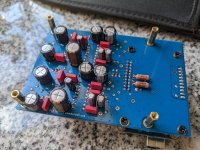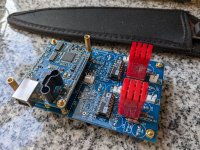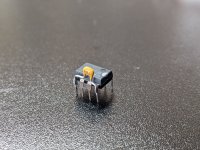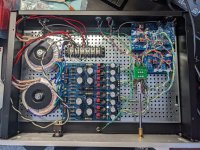You might try not talking to each other about what you hear until you finish listening and taking private notes about the sound of each opamp on the first round. Then you won't influence each other so much. Repeat the tests on at least three different days to see if your impressions are consistent. When comparing the sound of different devices, do not do something like focus attention on the bass of one device and then focus attention on the HF of another device. Much better to, say, for example, compare bass on each device, then compare HF for each device. Always rate devices on one aspect of the sound at a time. Makes it harder to fool yourself. Also, good to learn how to listen for small details, including small differences in presentation of the stereo illusion. That can be very difficult if using, say, something like a mediocre dac, which could possibly dominate errors in the reproduction system and or mask small differences in other devices. Much more could be said but I will stop here for now.
McGurk effect is a demonstration on how the visual cues can interfere with aural perception thus the importance of blind audio listening test but then that would blow the cover of boutique audio sales pitch so the attempt from the boutique audio businessmen to down play the importance of McGurk Effect.The McGurk effect is a demonstration that there isn't such a thing as 'the actual sound'. There are actual vibrations which are turned into sound by our brains. Which sound we get isn't purely dependent on the vibrations received at our ear drums.
Don't forget what your idol Jam wrote recently, "when I conducted this experiment, levels were matched to 0.1 dB"You might try not talking to each other about what you hear until you finish listening and taking private notes about the sound of each opamp on the first round. Then you won't influence each other so much. Repeat the tests on at least three different days to see if your impressions are consistent. When comparing the sound of different devices, do not do something like focus attention on the bass of one device and then focus attention on the HF of another device. Much better to, say, for example, compare bass on each device, then compare HF for each device. Always rate devices on one aspect of the sound at a time. Makes it harder to fool yourself. Also, good to learn how to listen for small details, including small differences in presentation of the stereo illusion. That can be very difficult if using, say, something like a mediocre dac, which could possibly dominate errors in the reproduction system and or mask small differences in other devices. Much more could be said but I will stop here for now.
Not only is there a quirky McGurk effect, there are optical illusions, and cognitive biases and heuristics. One can only conclude that all human perceptions and thought processes are completely unreliable and untrustworthy. Or, just maybe we can perform listening tests if we are careful and willing to spend some time practicing, just like we seem to be able to do a lot of other things in life despite being subject to some signal processing quirks.
As it pertains to the center line of the thread:
In order to get the Burson Op amps to fit my board, I had to build a second one with components on the bottom.
I was hoping to make some revisions anyway so it's not a huge deal in my case, but if I were less comfortable with soldering and I was working with factory built stuff, this would be a cautioning factor
(In case this is worrying anyone let it be known that I still need to clean flux off, so these photos are not the final for this board.)
In order to get the Burson Op amps to fit my board, I had to build a second one with components on the bottom.
I was hoping to make some revisions anyway so it's not a huge deal in my case, but if I were less comfortable with soldering and I was working with factory built stuff, this would be a cautioning factor
(In case this is worrying anyone let it be known that I still need to clean flux off, so these photos are not the final for this board.)
Attachments
Or maybe not. Can you cite a peer reviewed published research that we can?Or, just maybe we can perform listening tests if we are careful and willing to spend some time practicing, just like we seem to be able to do a lot of other things in life despite being subject to some signal processing quirks.
I was thinking of an app for the db meter, but if you already have a real one, all the better.Good idea. Maybe we'll run a test tone and meter it, that would be more accurate that an app I'd guess
@phase I don't have a db meter, but I am able to measure signal voltage from the RCAs out with something like a -3db test tone
@Vunce hey thanks friend! Fun to practice and learn. I'm reading through a text that rayma suggested, hoping to begin some of my own design work later this week. Currently buried in reading again now that the semester has started
@Vunce hey thanks friend! Fun to practice and learn. I'm reading through a text that rayma suggested, hoping to begin some of my own design work later this week. Currently buried in reading again now that the semester has started
Finished a full rebuild on my DAC and my friends will be over next week to test things out. I also have a box of Owens Corning 703, maybe I'll finally knock up some frames and get them on the ceiling -- intent is just to catch some of the obvious slapback and sibilance in the room.
And the NE5534's are externally compensated as per the Phillips spec sheet.
And the NE5534's are externally compensated as per the Phillips spec sheet.
Attachments
jotom, the Bursons are the most expensive by a large margin. Your point is clear.Have you a rundown of the op amps that you will be auditioning and their respective costs?
@jotom750 this is a hobbyist review and it's limited. So far people have offered criticism regarding price, blind testing protocol, my chosen vocabulary, choice of file format and source, etc etc. I hope it doesn't ruffle any feathers, but this hobbyist write up has also neglected to consult an institutional review board, so in the event that forum users believe I have violated audiophile ethics I will be fully liable. Risky, I know.
@InspectorGadget How interesting, I hadn't caught that. Reminds me of this country music podcast: https://cocaineandrhinestones.colortestmerch.com/collections/shop-all/products/soda-logo-crewneck
@InspectorGadget How interesting, I hadn't caught that. Reminds me of this country music podcast: https://cocaineandrhinestones.colortestmerch.com/collections/shop-all/products/soda-logo-crewneck
I helped out with a double blind opamp listening test once. I sanded the part numbers off the opamp chip-pairs, painted each pair a different color, then mailed them to the listening team 1000 miles away. Listeners knew the paint colors of the various opamps but not the part numbers, so they were not pre-biased by expectations such as "JFET opamps always sound too bright", or "Burr-Brown makes killer parts" or "I read on a website once that part number OPAxyz really sux".
The parts I sent were
Red = ADA4898-1
Green = LF356MX
Yellow = LM7321
White = LT1498
Silver = UA741 (!!!)
Blue = OPA209
The parts I sent were
Red = ADA4898-1
Green = LF356MX
Yellow = LM7321
White = LT1498
Silver = UA741 (!!!)
Blue = OPA209
Last edited:
Mark, I always thought OPA209 sounded bluer than other op amps.
That procedure sounds like a great idea, unfortunately I suspect I'd still be able to identify the Bursons even with the label sanded off. They are ever so slightly larger than a DIP8 (... they're enormous)
By the way, I finished Feynman's Sure you must be joking last night. I think I may bounce to a different author next but thanks for putting me on to him. Interesting individual and definitely someone who exists in his own time frame and context.
Also I recognize that this comparison fits the criteria for cargo cult, but I am not comfortable asking one of my friends to wait alone in a different part of my home for a few hours in order to tighten up the double-blind.
That procedure sounds like a great idea, unfortunately I suspect I'd still be able to identify the Bursons even with the label sanded off. They are ever so slightly larger than a DIP8 (... they're enormous)
By the way, I finished Feynman's Sure you must be joking last night. I think I may bounce to a different author next but thanks for putting me on to him. Interesting individual and definitely someone who exists in his own time frame and context.
Also I recognize that this comparison fits the criteria for cargo cult, but I am not comfortable asking one of my friends to wait alone in a different part of my home for a few hours in order to tighten up the double-blind.
- Home
- Design & Build
- Parts
- Op Amp blind test: Burson, ADA4627, NE5534




